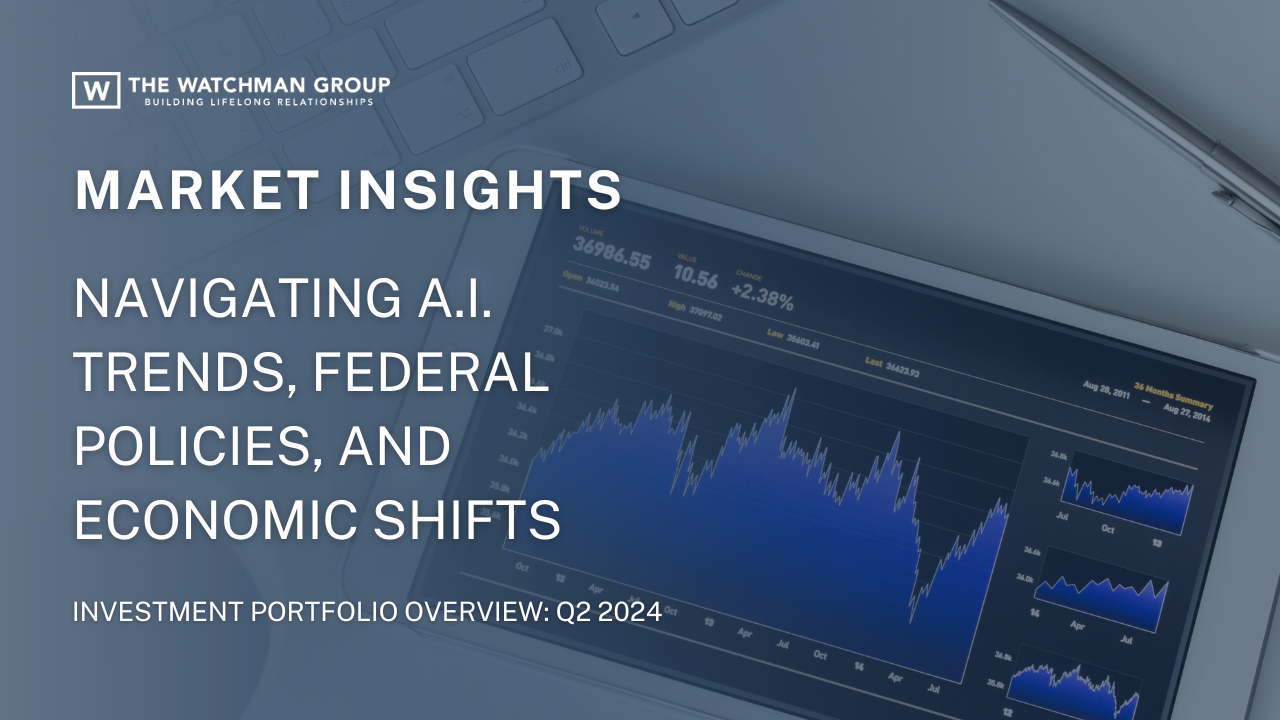Investment Portfolio Overview: Q2 2024
The two areas that captivated the attention of the financial markets this quarter were AI (Artificial Intelligence) and the anticipation of the Federal Reserve beginning to lower interest rates.
The Impact of AI and Market Rotation
There is always an abundance of excitement at the dawn of any new technological revolution – and AI is no exception. It is natural for investors to want to be at the forefront of new trends and make investments in those companies that may benefit. Interestingly, many of the names investors feel could benefit the most are already some of the largest companies in the world, leading to a divide in the market. While the Russell 1000 large-cap stock index had a quarterly rise of 3.5%, the average stock in that index declined 4%. Smaller companies didn’t fare well either, with the Russell 2000 small-cap index declining 3.4% for the quarter. Essentially, the bigger the company, the better the return this quarter. However, this trend reversed entirely in July as money moved from large companies to small ones, leading to a strong start for small-cap stocks in the third quarter, with a 10% rise in just the first 25 days of July, a good omen for the rest of the year.
Fixed-Income Market Performance and Strategy
Investment returns were not as interesting in the fixed-income markets. The bond market index notched a small gain during the quarter, but total returns are still down a bit for the year. The price of the 10-year Treasury fell slightly, with its yield edging higher to close the quarter at 4.47%. Fortunately, our emphasis on shorter maturities (under 5 years) helped Watchman fixed-income portfolios buck the trend and earn positive returns as prices for short-term maturities increased. There’s also good news on inflation, which has slowed down to a manageable 2.5% annual rate, according to the Personal Consumption Index (PCE). The bond market continues to offer a fair return above inflation with taxable yields between 4%-6%.
Federal Reserve’s Tightrope: Inflation vs. Recession
The Federal Reserve knows it is walking a tightrope on monetary policy. Its goal has always been to lower the inflation rate to its 2% target without pushing the economy into a recession. It appears that the Fed is finally getting the inflation data it needs to begin lowering short-term interest rates, and has been hinting at a policy shift in its comments to the markets. Lower interest rates would be welcomed by small businesses and families that need to finance large ticket purchases like cars and homes.
Economic Growth, Unemployment, and Market Volatility
As the economy continues to grow modestly, many strategists now believe the “soft landing” scenario is the most likely outcome. We feel it is premature to conclude the coast is clear for the economy as we haven’t yet felt the full impact of higher rates. Retail sales are starting to slow as consumers seem tired following a binge of post-COVID spending. Comments from retailers, airlines, restaurants and automakers are confirming these trends. While there are signs that a recovery in industrial goods could be around the corner, the present environment remains soft. What is encouraging is that economists monitoring real-time data are projecting the economy will grow at around a 2% clip this quarter.
Something we believe warrants monitoring is the unemployment rate. At face value, employment is strong, and the unemployment rate sits at a historically low 4.1%. However, it has risen 0.5% from its all-time low of 3.6%. While this may not seem like a big change, in the past when unemployment began moving either higher or lower the trend can last for a while. This is why the Federal Reserve needs to be careful not to slow economic growth too much. The Fed is well aware of its dual mandate to promote both price stability and full employment. Expect much more volatility within the financial markets over the next few months as investors try to understand where the economy and monetary policy are headed. It has been several quarters since the stock market last experienced even a 10% correction, but they can happen at any time and without warning. When swift corrections do occur, know that there are temporary bumps in the long-term upward trend.
The Variability of Capital Gains in 2024
In our last quarterly letter, we brought up the issue of capital gains and why they are likely to be high again in 2024. The strong rise in stock prices over the last few years has made it necessary to rebalance portfolios. No stock should be held forever, and there will eventually come a time when it is wise to take some chips off the table and diversify into more attractive areas of the market or reduce risk by moving into bonds. Note that capital gains only apply to non-retirement accounts and can vary significantly depending on how long you’ve been with the firm. If you are curious to know where you stand on capital gains, a report is provided in your quarterly report. Additionally, if you would like an analysis of your current tax situation, please contact us for a tax review.
Election Season: Focus on Long-Term Business Growth
Let’s conclude with our thoughts on the upcoming elections. We are not going to predict which candidate will win the Presidency or which party will control Congress, nor will we try to make investment decisions based on potential outcomes. Instead, we will remain focused on being owners of great businesses that provide an economic benefit to society, as these companies can succeed no matter what happens in Washington. Politics can certainly create a headwind, or a tailwind, for some businesses or areas of the economy and we are mindful of political outcomes for these reasons. But ultimately it is the ingenuity of American business, and American citizens waking up every day working to make the world a better place for themselves and others, that matter most.


